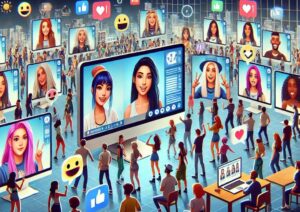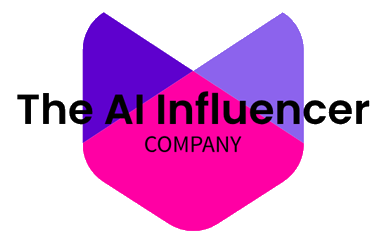AI-generated personas like Imma, Lil Miquela, and Shudu Gram now work with labels to offer fresh appeal. These fictional ambassadors provide new opportunities for audience engagement. Brands leverage their mystique and interactive messaging to connect with consumers.
The shift represents a seismic change for the industry. Just a few years ago, CGI influencers seemed like futuristic speculation. But their unique draw catalyzed meteoric adoption across fashion houses. From high fashion to mass-market, virtual avatars reshape strategy.
Let’s explore how AI influencers like Lil Miquela are disrupting paradigms, capturing consumer imagination, and spearheading digital trends. Their fiction-to-reality rise has opened up possibilities unimagined just recently. The age of virtual influencers has arrived.
How AI Influencers Reach Massive Audience Reach
The secret sauce behind Lil Miquela and friends boils down to numbers far surpassing human star power. Miquela alone amasses 2.7 million Instagram followers. Shudu Gram boasts over 241,000 enraptured fans. Even more niche CGI persona Noonoouri commands 431,000 sets of eyeballs.
Their outsized traction stems from several factors:
- Novelty – An air of innovation and excitement lingers around the blended space meshing advancing technology and cultural influence into speculative realms once relegated to science fiction. Fans feel part of something pioneering.
- Mystique – With no human ownership element, followers obsess over who or what algorithmic forces shape the character’s arcs and sponsorship opportunities. It becomes a puzzle to decode in itself.
- Interactivity – While not fully autonomous AIs (yet), Lil Miquela and peers trade messages and Respond to audience reactions more reliably than human celebs ever could between shoots, parties and scandals.
- Aspiration – The perfection, poise and boundless potential of CGI creations provide ultimate escapism contrasting the imperfect realities of human celebs.
Brands Embrace AI Influencers
For major fashion labels and retailers, partnering with futuristic AI avatars like Lil Miquela often makes far more strategic sense than deals with human celebrity talent. Virtual influencers present unique creative opportunities while eliminating many of the costs, risks, and constraints associated with traditional celebrity sponsorships.
Before diving into the key benefits driving adoption, it’s important to understand just how rapidly usage has exploded across the industry. In 2019, only about 100 brand sponsorships involved CGI influencers. The influencer marketing business is estimated to reach more than $17 billion this year.
Driving this hockey stick growth? Everything from next-gen appeal to stability has compelled brands across fashion’s spectrum to embrace virtual influencers as a key part of a strategy.
Cost Savings And Wider Reach
Partnering with an AI influencer provides major cost savings compared to human celebrity deals while reaching a much wider demographic appeal. Lil Miquela and her CGI peers offer the best of both worlds – reduced costs and expanded reach.
- An AI influencer like Miquela costs a fraction of a supermodel’s fee but offers algorithmic likability across demographics. Brands like Prada have achieved 70% cost savings using her.
- Miquela resonates from Gen Z to seniors, across countries and cultures – a much broader reach than human stars.
- Freelance models often charge between $50 and $250 per hour, whereas agency models may charge an additional 20% fee on top of their hourly pay. On the other hand, virtual photography is a more cost-effective option and means it is easier to save money and make money.
Compared to deals with human supermodels or celebrity ambassadors, partnering with an AI influencer like Lil Miquela costs a mere fraction of the price. But remarkably, these virtual avatars often resonate with a much broader, diverse demographic reach than human stars can attain.
Reliability and Scandal-Proof Personas
Unlike unpredictable human celebrities, AI influencers offer reliable, gaffe-free activations critical for brand control. Their consistency results in stability and trust that human stars cannot match.
- Unlike unpredictable human celebs, virtual avatars deliver consistent, scandal-free content without risks. Their reliability gives brands maximum control and stability for campaigns.
- Their reliability ensures maximum control and stability for brand campaigns without risks.
- Perceived as authentic, but without ego, fatigue, or controversy of human stars.
Unlike unpredictable human celebrities who carry risks like sudden controversies or reliability issues, virtual influencers deliver consistent, scandal-free activations. Their algorithmic nature provides maximum control and stability for brand campaigns.
Creative Freedom for Brand Building
The blank canvas of virtual avatars provides endless options for brands to craft tailored personas and backstories aligned with campaign goals.
- Blank slate nature allows custom CGI personas tailored to brand values and imagery.
- Brands can meticulously shape backstories, looks, and messaging aligned to their ethos.
- Enables diverse traits tailored to brand identity – activism, elegance, edginess, etc.
The blank slate nature of AI avatars empowers fashion labels to meticulously craft custom personas tailored to their ethos and image. This enables diverse traits aligned to a brand’s identity, from elegance to edginess and beyond.
Industry Adoption
The usage of virtual influencers by fashion brands has exploded over the past few years. These CGI avatars have gone from novelties to key parts of marketing strategy for labels across the spectrum.
More than just early adopters, a critical mass of major fashion houses, mass-market brands, and retailers are now leveraging virtual influencers regularly.
- Luxury powerhouses like Gucci, Dior, and Louis Vuitton have worked with AI influencers across multiple digital campaigns and activations. These top-tier brands are investing heavily in partnerships with CGI stars.
- Mainstream fast fashion labels like H&M, Forever21, and Zara are rapidly following suit as adoption spreads beyond high fashion. Mass market brands want part of the action.
The growth has been staggering. This hockey stick growth shows no signs of slowing either – by 2026, credible industry forecasts predict that 25% of all brand influencer sponsorships will involve virtual talent.
Several key factors are propelling these incredible adoption rates across the fashion world:
- Lower production costs compared to traditional celebrity deals. Lil Miquela and CGI influencer sponsorships cost a fraction of deals with comparable human stars.
- Broader demographic appeal that resonates across age, gender and culture. AI avatars attract Gen Z to seniors.
- Novelty and excitement factors around cutting-edge technology and immersive digital spaces.
Audience Sentiment Trends
Early research indicates positive perceptions may be growing around virtual influencers. However, comprehensive data is still limited at this relatively nascent stage of adoption.
A blog post on HubSpot discusses the reasons why people are drawn to AI influencers, such as their novelty, aspirational content, and psychological distance.
As avatar technology progresses and evolves, large-scale studies tracking changes in consumer acceptance over time will provide valuable insights. But conclusions remain premature pending rigorous sentiment research.
AI Influencers Fashion Trends
Beyond advertising roles, avant-garde virtual personas like Lil Miquela are actively pioneering and driving major trends at the intersection of technology and fashion. Their presence is melding human and artificial digital spaces in groundbreaking ways like virtual runway shows and Gen Z Anchor.
Virtual Runway Shows
CGI influencers have carved out unique roles in modern virtual runway shows and events. Their participation provides a compelling new dimension to digital fashion like:
- During the pandemic, Miquela walked the digital catwalk alongside human supermodels like Bella Hadid. Even as physical shows resume, the allure and exclusivity of virtual presentations now appears here to stay.
- Avatar relatability contrasted against distant human celebrity provides a new dimension for youth-oriented brands. CGI influencers enhance digital runway accessibility and heighten anticipation.
Gen Z Anchor
As an algorithmically crafted avatar, Lil Miquela resonates strongly with Gen Z and represents a shifting perception of authenticity in ways:
- Where past generations aspired towards surgically enhanced or beautified perfection, Gen Z identifies authenticity through imperfect, algorithmically crafted avatars. AI personas built from the inside out resonate strongly.
- Seeing virtual influencers support social causes also boosts brand image among progressive youth. Miquela shapes her identity as an activist for equality and justice. Her outspokenness on issues anchors Gen Z’s loyalty.
Final Thoughts
As AI technology progresses, virtual avatar realism and believability will only heighten over time through computing advances. It remains to be seen whether the novelty of CGI influencers wears off or if society fully accepts the artificial over real.
However early adoption and engagement trends provide a glimpse into a future melding of human and digital influencer cultures. Powered by everything from cost savings to specialized appeal, these AI avatars have underscored their expanding roles. The fashion industry’s early embrace hints at a coming new normal.




